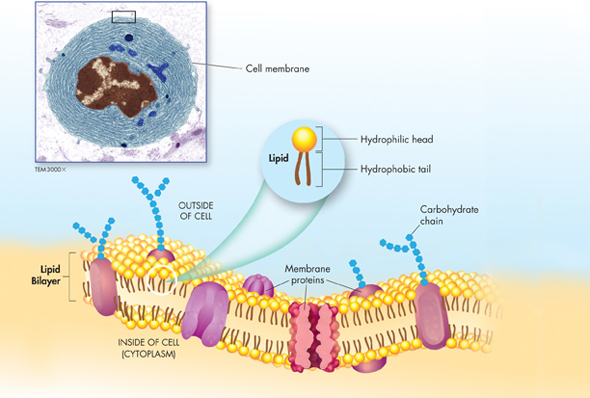Cell Membranes All cells contain cell membranes, which almost always are made up of a double-layered sheet called a lipid bilayer, as shown in Figure 7–13. The lipid bilayer gives cell membranes a flexible structure that forms a strong barrier between the cell and its surroundings.  The cell membrane regulates what enters and leaves the cell and also protects and supports the cell.
The cell membrane regulates what enters and leaves the cell and also protects and supports the cell.
▸ The Properties of Lipids The layered structure of cell membranes reflects the chemical properties of the lipids that make them up. You may recall that many lipids have oily fatty acid chains attached to chemical groups that interact strongly with water. In the language of a chemist, the fatty acid portions of this kind of lipid are hydrophobic (hy druh FOH bik), or “water-hating,” while the opposite end of the molecule is hydrophilic (hy druh FIL ik), or “water-loving.” When these lipids, including the phospholipids that are common in animal cell membranes, are mixed with water, their hydrophobic fatty acid “tails” cluster together while their hydrophilic “heads” are attracted to water. A lipid bilayer is the result. As you can see in Figure 7–13, the head groups of lipids in a bilayer are exposed to the outside of the cell, while the fatty acid tails form an oily layer inside the membrane that keeps water out.
ZOOMING IN
THE CELL MEMBRANE

FIGURE 7–13 Every cell has a membrane that regulates the movement of materials. Nearly all cell membranes are made up of a lipid bilayer in which proteins and carbohydrates are embedded.
Apply Concepts Explain why lipids “self-assemble” into a bilayer when exposed to water.
dTable of Contents
- Formulas and Equations
- Applying Formulas and Equations
- Mean, Median, and Mode
- Estimation
- Using Measurements in Calculations
- Effects of Measurement Errors
- Accuracy
- Precision
- Comparing Accuracy and Precision
- Significant Figures
- Calculating With Significant Figures
- Scientific Notation
- Calculating With Scientific Notation
- Dimensional Analysis
- Applying Dimensional Analysis




